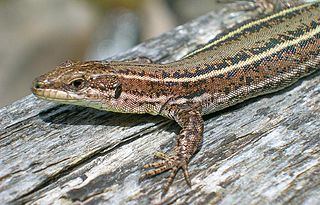
Podarcis is a genus of lizards in the family Lacertidae. Its members look very similar to lizards of the genus Lacerta, to which they were considered to belong until the 1970s. While similar externally and ecologically, Podarcis form a distinct group differing from Lacerta by the construction of the skull and the hemipenis, and by the processes of the caudal vertebrae. They are commonly known as wall lizards. They are native to Europe and northern Africa, and most species are restricted to the Mediterranean region. Wall lizards diversified and hybridized during the Messinian salinity crisis. The Italian wall lizard and the common wall lizard have been introduced to North America, where they have become intermediate hosts for some Acuariidae larvae.

Erhard's wall lizard, also commonly called the Aegean wall lizard, is a species of lizard in the family Lacertidae. The species is endemic to Southeast Europe.

The Milos wall lizard is a small Mediterranean lizard.

Podarcis muralis is a species of lizard with a large distribution in Europe and well-established introduced populations in North America, where it is also called the European wall lizard. It can grow to about 20 cm (7.9 in) in total length. The animal has shown variation in the places it has been introduced to. Fossils have been found in a cave in Greece dating to the early part of the Holocene.

Podarcis hispanicus, also known as Iberian wall lizard, is a small wall lizard species of the genus Podarcis. It is found in the Iberian Peninsula, in northwestern Africa and in coastal districts in Languedoc-Roussillon in France. In Spanish, this lizard is commonly called lagartija Ibérica.

Bocage's wall lizard is a species of lizard in the family Lacertidae. The species is endemic to the Iberian Peninsula. Its natural habitats are temperate forests, temperate shrubland, Mediterranean-type shrubby vegetation, sandy shores, rural gardens, and urban areas. The IUCN does not consider it to be threatened.

Podarcis carbonelli, commonly known as Carbonell's wall lizard, is a species of lizard in the family Lacertidae. The species is native to Portugal and Spain.

Lilford's wall lizard is a species of lizard in the family Lacertidae. The species is endemic to the Gymnesian Islands, the easternmost of the Balearic Islands, Spain.

The Peloponnese wall lizard is a species of lizard in the family Lacertidae. It is endemic to the Peloponnese region of southern Greece. Its natural habitats are Mediterranean-type shrubby vegetation, rocky areas, arable land, pastureland, plantations, and rural gardens.

The Aeolian wall lizard, also known commonly as Raffone's wall lizard, is a species of lizard in the family Lacertidae. The species is endemic to Italy.

The Italian wall lizard or ruin lizard is a species of lizard in the family Lacertidae. P. siculus is native to south and southeastern Europe, but has also been introduced elsewhere in the continent, as well as North America, where it is a possible invasive species. P. siculus is a habitat generalist and can thrive in natural and human-modified environments. Similarly, P. siculus has a generalized diet as well, allowing it to have its large range.

The Sicilian wall lizard is a species of lizard in the family Lacertidae. Endemic to Italy, it occurs in Sicily and the Aegadian Islands. Its natural habitats are temperate forests, temperate shrubland, Mediterranean-type shrubby vegetation, temperate grassland, arable land, pastureland, and rural gardens. The IUCN does not consider it to be a threatened species. Three subspecies are recognized: P. w. antoninoi, P. w. marettimensis, and P. w. waglerianus.

Podarcis tauricus, the Balkan wall lizard, is a common lizard in the family Lacertidae native to southeastern Europe and Asia Minor. It is a terrestrial species found in steppe, grassland, olive groves, cultivated land, meadows, rural gardens, sparsely vegetated sand dunes and scrubby areas.
Philipp Lehrs (1881–1956) was a German herpetologist who specialized in the lizard family Lacertidae. During his career, he was associated with the Zoologischen Forschungsinstitut and Forschungsmuseum Alexander Koenig in Bonn.

Podarcis cretensis, the Cretan wall lizard, is a species of lacertid lizard endemic to Crete.

Podarcis virescens, also known by its common name as Geniez's wall lizard, is a lizard species of the Lacertidae family. Podarcis virescens is commonly found in the Iberian Peninsula, including Spain and Portugal. The lizard's name is derived from Latin due to its color turning from a usual brown color to green during the spring. Podarcis virescens are a moderate sized lizard and robust in build. Colors vary during seasons and range between individuals from white, brown, green, and black. Podarcis virescens have been found in villages and other human-populated areas in Spain and Portugal at elevations of around 840 meters.
Podarcis latastei, the Pontian wall lizard, is a species of lizard in the family Lacertidae. It is endemic to Italy.















